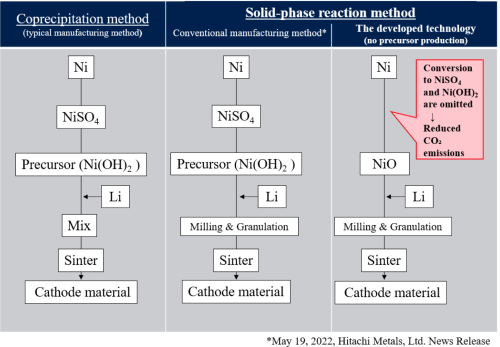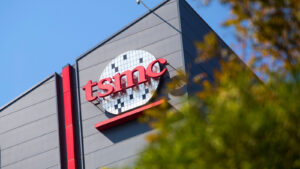Energy & Critical Metals
Proterial developed a technology that reduces CO2 emissions during Li-ion cathode material production by more than 20%
Proterial, Ltd., (formerly Hitachi Metals, earlier post) has developed a technology to manufacture cathode materials for lithium-ion batteries (LIBs) without…

Proterial, Ltd., (formerly Hitachi Metals, earlier post) has developed a technology to manufacture cathode materials for lithium-ion batteries (LIBs) without the previously required process of converting nickel to nickel hydroxide(Ni(OH)2) to produce a precursor that is used as the starting material for the manufacture of cathode materials.
The developed technology enables CO2 emissions during the production of cathode materials to be reduced by more than 20% compared to the manufacturing method based on the solid phase reaction method (announced in May 2022) that Proterial had developed.
LIB manufacturing accounts for a large proportion of CO2 emissions in the EV manufacturing process, with the largest share of CO2 coming from the starting material for cathode material for high nickel-type batteries. In particular, large amounts of CO2 are emitted in the process of obtaining the precursor nickel hydroxide(Ni(OH)2) from nickel (Ni).
Proterial has successfully developed a technology for producing cathode materials with comparable electrochemical properties without going through the process of producing the starting material where nickel sulfate (NiSO4) is produced from metal nickel (Ni), and the precursor of nickel hydroxide(Ni(OH)2) is then produced from that. With the developed technology, Proterial has succeeded in reducing CO2 emissions from the starting material by more than 30% compared to the conventional manufacturing method.
Electrochemical properties
| Solid-phase reaction method | Discharge capacity (Ah/kg) | Capacity retention (%) |
| The developed technology (no precursor) | 192 | 90 |
| Conventional manufacturing | 190 | 88 |
| Composition: LiNi0.85Co0.03(Mn(0.12-a)Xa)O2 Discharge capacity conditions: 4.3-2.5V, 0.2C (25°C), Anode: Li metal Cycle conditions: 4.3-2.5V, 1C (25°C), Anode: Li metal |
||
This is equivalent to a 20% or greater reduction in CO2 emissions over the entire cathode material manufacturing process, including the production of starting materials.

Uranium Exploration Company Announces Additional Staking in the Athabasca Basin
Source: Streetwise Reports 12/22/2023
Skyharbour Resources Ltd. announced an update from its Canada-based Falcon Project along with additional…
Tesla Launches New Mega Factory Project In Shanghai, Designed To Manufacture 10,000 Megapacks Per Year
Tesla Launches New Mega Factory Project In Shanghai, Designed To Manufacture 10,000 Megapacks Per Year
Tesla has launched a new mega factory…
Giving thanks and taking stock after “a remarkable year”
An end-of-year thank you to our readers, industry colleagues and advertisers before Electric Autonomy breaks from publishing until Jan. 2
The post Giving…









